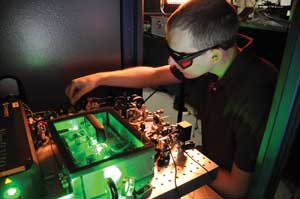Compiled by Photonics Spectra staff
A new low-noise oscillator generates
microwave signals more pure and stable than those from conventional electronic sources.
The instrument could improve signal stability and resolution in radar, communications
and navigation systems, and in certain types of atomic clocks.
Created by physicists at the National Institute of Standards and
Technology, the device is a new application of optical frequency combs – tools
based on ultrafast lasers for precisely measuring optical frequencies of light.
Frequency combs are used as “gears” for experimental next-generation
atomic clocks, converting optical signals to lower microwave frequencies that can
be counted electronically.
Because the instrument works so well, NIST scientists had to make
two copies of it so that they would have a separate tool precise enough to measure
the system’s performance. Each low-noise system is based on a continuous-wave
laser, with its frequency locked to the extremely stable length of an optical cavity
with a high-quality factor, assuring a steady, persistent signal.

University of Colorado graduate student Matt Kirchner fine-tunes an ultrastable microwave generator that he helps operate at NIST. Courtesy of Burrus/NIST.
This laser, which emitted yellow light in the demonstration but
could be another color, is connected to a frequency comb that transfers the high
level of stability to microwaves. The transfer process greatly reduces – to
one-thousandth of the previous level – random fluctuations in the peaks and
valleys, or phase, of the electromagnetic waves over time scales of 1 s or less.
This results in a stronger, purer signal at the exact desired frequency.
The device’s base microwave signal is 1 GHz, which is the
repetition rate of the ultrafast laser pulses that generate the frequency comb.
Its signal also can be a harmonic, or multiple, of that frequency. The laser illuminates
a photodiode that produces a signal at 1 GHz or any multiple up to ~15 GHz. For
example, many common radar systems use signals near 10 GHz.
These new oscillators may be useful in radar systems for detecting
faint or slow-moving objects, the physicists say. They also can be used to make
atomic clocks that operate at microwave frequencies. Other applications include
radio astronomy that couples signals from space with arrival times at multiple antennas,
and high-resolution analog-to-digital conversion of very fast signals for communications
or navigation.
Research findings appeared online June 26 in Nature Photonics
(doi: 10.1038/nphoton.2011.121).